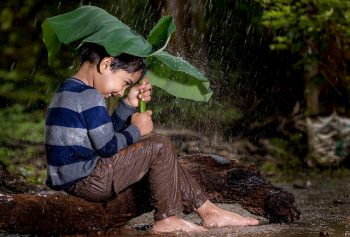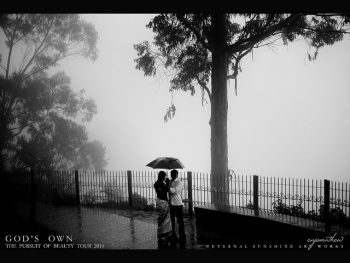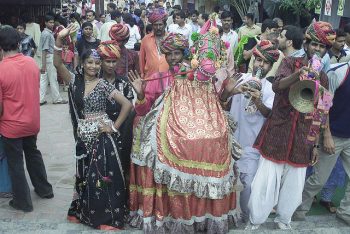The Meaning of the Monsoon Posted by Rachael on Jul 31, 2017 in Hindi Language, Uncategorized
In North India, monsoon season lasts roughly from July to August and is colloquially known as “saawan” (सावन, masc. noun, which is also the name of the 5th month of the Indian calendar). In the semi-desert state of Rajasthan, where I used to live, this season is understandably greeted with anticipation and joy. Mangoes are a particularly prized fruit of this season, with many different varieties of the delicious fruit becoming available in local markets with the beginning of the rainy season. Yet, rain is not just “rain” in a region of the world (I refer here specifically to North India, although South India and other regions of the country are also affected by the monsoon) in which the majority of rainfall occurs during two or three months. The monsoon has immense cultural, historical and economic significance that one should attempt to understand if one wants to delve deeper into the Hindi language and its attendant culture.
Read the dialogue below carefully between a Hindi teacher and her American student to find out more about the significance of the monsoon:
सारा: अदिति जी, मैंने हिंदी फ़िल्मों में देखा है कि सावन की बहुत बड़ी महत्त्व है । ऐसा क्यों है?
Sarah: Aditi ji, maine Hindi filmo me dekha hai ki saavan ki bahut bari mehettva hai. Aisa kyoon hai?
Sarah: Aditi ji, I’ve seen (noticed) in Hindi films that the monsoon has a lot of significance. Why is that?
अदिति जी: ख़ैर, सारा, उत्तर भारत जैसे क्षेत्र में, जहाँ पर आम तौर से बहुत बारिश नहीं होती है, वहाँ पर लोग बारिश में बहुत महत्त्व रखते हैं; जैसे कि, बॉलीवुड वाली फ़िल्मों में आम तौर से बारिश मुख्य जोड़ी की “Romance” (रोमांस) से जुड़ी हुई है ।
Aditi ji: Khair, Sarah, Uttar Bhaarat jaise kshetra me, jahaan par aam taur se bahut baarish nahin hoti hai, vahaan par log baarish me bahut mehettva rakhte hain; jaise ki, Bollywood vaali filmo me aam taur se baarish mukhya jori ki “Romance” se juri hui hai.
Aditi ji: Well, Sarah, in a region like North India, where there usually isn’t a lot of rain, (there) people regard rain as being significant; for example, in Bollywood films, usually rain is associated with the “Romance” of the main couple.
सारा: हाँ ! जब हमने “श्री ४२० (420)” देखी तो उसमें बड़ा अच्छा गाना है—क्या नाम था उसका? हाँ, “प्यार हुआ, इक़रार हुआ है” । वह तो अभी भी बहुत लोकप्रिय गाना है और उसमें दोनों चरित्र छाता के नीचे बारिश में अपने प्यार के बारे में गा रहे हैं ।
Sarah: Haan! Jab humne “Shree 420” dekhi to usme baraa acchaa gaanaa hai—kyaa naam thaa uskaa? Haan, “Pyaar Hua, Ikraar hua hai.” Voh to abhi bhi bahut lokpriya gaanaa hai aur usme dono charitra chhaataa ke neeche baarish me apne pyaar ke baare me gaa rahe hain.
Sarah: Yes! When we saw “Mr. 420” (a movie), there was a very good song in it—what was its name? Yes, “There’s love, a promise has been made” (इक़रार/ikraar could also mean an agreement or a confession). That is still a very popular song and in it both characters are singing about their love underneath an umbrella in the rain.
अदिति जी: हाँ, वह तो है । लोकप्रिय फ़िल्मों के साथ, भारतीय साहित्य में भी बारिश (और सावन) प्यार से जुड़ी है, जैसे कि पुराने सूफ़ी काव्यों में, जैसे “मृगावती” में, एक साहित्यिक चीज़ होती है जिसका नाम “बारह मासा” (मासा=महिना) । इसमें लेखक बारह ऋतुअों का वर्णन करता है और सावन में आम तौर से प्रेमी घर के बाहर बहुत महिनों से यात्रा कर रहा है और काम कर रहा है और प्रेमिका उसकी राह देख रही है और उसको बहुत तेज़ी से प्रेमी की याद आ रही है ।
Aditi ji: Haan, voh to hai. Lokpriya filmo ke saath, Bharatiy saahitya me bhi baarish (aur saavan) pyaar se juri hai, jaise ki puraane Sufi kaavyon me, jaise “Mrigavati” me, ek saahityik cheez hoti hai jiskaa naam “Baarah Maasaa” (maasaa=mahinaa). Isme lekhak baarah rituon kaa varnan kartaa hai aur saavan me aam taur se premi ghar ke baahar bahut mahino se yaatraa kar raha hai aur kaam kar raha hai aur premikaa uski raah dekh rahi hai aur usko bahut tezi se premi ki yaad aa rahi hai.
Aditi ji: Yes, that’s true (there’s that). Besides popular films, in Indian literature too rain is associated with love, such as in old Sufi epic poems, like in “The Mrigavati” (“The Golden Doe”), there’s a literary device (lit.: thing) whose name is “Baarah Maasaa” (“Twelve Months”). In this, the writer describes the twelve seasons (or months) and, in the rainy season, usually the male lover has been traveling and working outside the home for many months and the female lover is waiting for him and missing him terribly.
सारा: अच्छा, समझ गयी । बहुत दिलचस्प है । और ख़ास तौर पे राजस्थानी लोग सावन के बारे में क्या क्या सोचते हैं?
Sarah: Acchaa, samajh gayi. Bahut dilchasp hai. Aur khaas taur pe Rajasthani log saavan ke baare me kyaa kyaa sochte hain?
Sarah: Okay, I understand. (This) is very interesting. And what do Rajasthani people specifically think about the rainy (monsoon) season?
अदिति जी: राजस्थानी लोग क्योंकि रेगिस्तान जैसी जगह में रहते हैं, इसलिये कि वे बहुत उत्साह से साल भर सावन का इंतज़ार करते हैं । खास तौर से, किसान सावन का इंतज़ार करते हैं क्योंकि अगर सावन में बहुत बारिश नहीं हुई, तो काफ़ी खाना नहीं होगा और लोग भूखे रहेंगे । सावन में ही बहुत अनोखा खाना मिल सकता है । अलग अलग फल मिल सकते हैं, जैसे कि अलग अलग तरह के आम हैं, जामुन है जो “plum” जैसा लगता है लेकिन थोड़ा सा खट्टा है । और लीची भी मिल सकते हैं जो बहुत ही स्वाद है !
Aditi ji: Rajasthani log kyoonki registaan jaisi jagah me rehte hain, isliye ki ve bahut utsaah se saal bhar saavan kaa intazaar karte hain. Khaas taur se, kisaan saavan ka intezaar karte hain kyoonki agar saavan me bahut baarish nahin hui, to kaafi khaanaa nahin hogaa aur log bhooke rahenge. Saavan me hi bahut anokhaa khaanaa mil sakta hai. Alag alag phal mil sakte hain, jaise ki alag alag tarah ke aam hain, jaamun hai jo “plum” jaisaa lagtaa hai lekin thoraa saa khatthaa hai. Aur lychee bhi mil sakte hain jo bahut hi svaad hai!
Aditi ji: Rajasthani people, because they live in a desert-like place, (therefore) they await the rainy season with a lot of enthusiasm. Farmers especially await the rainy season because if there wasn’t a lot of rain during the monsoon, there won’t be enough food and people will go hungry. In the rainy season itself, you can find a lot of unique foods. You can find a lot of fruit, like different types of mangoes, jamun, which looks like a plum but is a little bit sour. And you can also find lychees, which are very delicious!
सारा: क्या बात है! हाँ, मैंने बाज़ार में उनको देख लिया है —मैंने कभी जामुन नहीं खाया है लेकिन एक दिन ज़रूर छक लूँगी !
Sarah: Kyaa baat hai! Haan, maine baazaar me unko dekh liyaa hai—Maine kabhi jaamun nahin khaayaa hai lekin ek din zaroor chhak loongi!
Sarah: Wow! Yes, I’ve seen them in the market. I’ve never eaten a jamun but I’ll definitely try one some day!
अदिति जी: हाँ, ज़रूर छकना चाहिए । फल के अलावा, सावन में, अगस्त के आरंभ में लोग एक त्यौहार मनाते हैं जिसका नाम “तीज” है । इसमें लोग पारवती देवी की पूजा करते हैं और जयपुर के पुराने शहर में लोग बड़ा जुलूस देख सकते हैं । पुराने ज़माने में सिर्फ़ अौरतें जुलूस देख सकती थीं और लोग मानते थे कि त्यौहार खास तौर से महिलाअों के लिये था लेकिन अभी ऐसा नहीं है और सब लोग मना सकते हैं ।
Aditi ji: Haan, zaroor chhaknaa chaahiye. Phal ke alaavaa, saavan me, August ke aarambh me log ek tyauhaar manaate hain jiskaa naam “Teej” hai. Isme log Parvati devi ki pujaa karte hain aur Jaipur ke puraane sheher me log baraa juloos dekh sakte hain. Puraane zamaane me sirf aurate juloos dekh sakti thin aur log maante the ki tyauhaar khaas taur se mahilaaon ke liye thaa lekin abhi aisaa nahin hai aur sab log manaa sakte hain.
Aditi ji: Yes, you should definitely try it. Besides fruit, in the rainy season, at the beginning of August, people celebrate a festival called “Teej.” In it, people pray to Parvati (a Hindu goddess, consort of Shiva) and in Jaipur’s old city, people can watch a big parade. In the olden days, only women could watch the parade and people believed that the festival was especially for ladies but now that’s not the case and everyone can celebrate it.
सारा : बहुत मज़ेदार लगता है । उस के अलावा लोग क्या करते हैं?
Sarah: Bahut mazedaar lagtaa hai. Us ke alaavaa log kyaa karte hain?
Sarah: It seems really fun. What do people do besides that?
अदिति जी: उस के अलावा, सावन में अौरतें कभी कभी व्रत रखती हैं तीज के लिये और आम खाना नहीं खाती, सिर्फ़ फल खाती हैं और थोड़ा सा पानी पीती हैं; लोग मानते हैं कि यह बहुत शुभ समय है व्रत रखने के लिए । सावन ज़रूर मेरा मनपसंद ऋतु है; अब के लिए तुम्हारी जिज्ञासा संतुष्ट है ? (मुसकुरा रही है)
Aditi ji: Us ke alaavaa, saavan me aurate kabhi kabhi vrat rakhti hain Teej ke liye aur aam khaanaa nahin khaati, sirf phal khaati hain aur thora sa paani peeti hain; log maante hain ki yeh bahut shubh samay hai vrat rakhne ke liye. Saavan zaroor meraa manpasand ritu hai; ab ke liye tumhaari jigyaasaa santusht hai? (muskuraa rahi hai)
Aditi ji: Besides that, women sometimes fast during the rainy season for Teej and do not eat ordinary food, (they) only eat fruit and drink a bit of water; people believe that this is a very auspicious time for fasting. The rainy season is definitely my favorite season; is your curiosity satisfied for now? (smiling)
सारा : जी हाँ ! अब मैं वे फल खाना चाहती हूँ जिनके बारे में आपने मुझे बताया । आप मेरे साथ बाज़ार चलेंगी ?
Sarah: Ji haan! Ab main ve phal khaanaa chahti huun jinke baare me aapne mujhe bataayaa. Aap mere saath bazaar chalengi ?
Sarah: Yes, ma’am! Now I want to eat (try) those fruits that you told me about. Will you come to the market with me?
अदिति जी: ज़रूर ! मुझे भी कुछ सावन के फल खाने हैं । चलें !
Aditi ji: Zaroor! Mujhe bhi kuch saavan ke phal khaane hain. Chalen!
Aditi ji: Definitely! I also want to eat some “Saawan” fruits. Let’s go!
Here’s the famous song Sarah mentioned in the dialogue from the film “Shree 420” (श्री ४२० or “Mr. Thief”):

Build vocabulary, practice pronunciation, and more with Transparent Language Online. Available anytime, anywhere, on any device.







